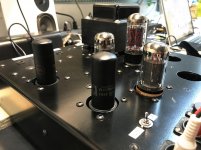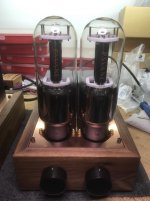Popped in these metal can 6V6's for gain mode.
I wondered if they would be less microphonic- not really actually.
The hum and noise I think are a little less than the Tung Sol reissues.
More than anything the noise is just.... different.
They sound pretty good overall though! They definitely get hot and look tough!
I wondered if they would be less microphonic- not really actually.
The hum and noise I think are a little less than the Tung Sol reissues.
More than anything the noise is just.... different.
They sound pretty good overall though! They definitely get hot and look tough!
Attachments
I wonder, would 7.5dB gain be enough for you? In other words two and a half times lower than you now got. That change can be implemented with a negative feedback network. Add 120K in series between the input (after the pot) and the 1K grid stopper. From their node connect a 560K resistor to the stage's output (after the output capacitor). Microphony will go down, noise will go down, THD will go down. Easy to do, evaluate and decide.
Don't use a higher than 50K volume pot with this arrangement. Matter of the pot's output impedance interfacing. Otherwise let me know to give you alternative values if you use a 100K pot or in case you want a different gain.
Don't use a higher than 50K volume pot with this arrangement. Matter of the pot's output impedance interfacing. Otherwise let me know to give you alternative values if you use a 100K pot or in case you want a different gain.
Yup, grounded pin 1 via nearby chassis screw and short wire.
Thanks for this suggestion. I'm going to save this post for later because I'd like to implement it at some point. I really like the idea.
Right now I do need the gain, because I'm using it a lot as a headphone amp and it's just the right amount of gain. And in phones, it's dead silent all around.
And to be fair, running the gain stage into my current amp with 27dB of gain is not quite fair. But once I get my other amp complete that has 12db gain, 7.5dB gain might be just fine.
I'm going to implement the DC heaters solution at some point too. Yesterday while I had it open, I disconnected the CT from gnd on the heater windings, and connected it to the top of the cathode resistor. That point is only +14V, so maybe not optimal, but it did reduce the hum a bit, but for some reason the tube became more microphonic- weird! So connected back to gnd. Maybe DC heaters will be the final refinement.
So I'll keep everything as it is for now, and just sit back and enjoy. CF into amp sounds killer, and I've never enjoyed headphones this much.

Thanks for this suggestion. I'm going to save this post for later because I'd like to implement it at some point. I really like the idea.
Right now I do need the gain, because I'm using it a lot as a headphone amp and it's just the right amount of gain. And in phones, it's dead silent all around.
And to be fair, running the gain stage into my current amp with 27dB of gain is not quite fair. But once I get my other amp complete that has 12db gain, 7.5dB gain might be just fine.
I'm going to implement the DC heaters solution at some point too. Yesterday while I had it open, I disconnected the CT from gnd on the heater windings, and connected it to the top of the cathode resistor. That point is only +14V, so maybe not optimal, but it did reduce the hum a bit, but for some reason the tube became more microphonic- weird! So connected back to gnd. Maybe DC heaters will be the final refinement.
So I'll keep everything as it is for now, and just sit back and enjoy. CF into amp sounds killer, and I've never enjoyed headphones this much.

I wonder, would 7.5dB gain be enough for you? In other words two and a half times lower than you now got. That change can be implemented with a negative feedback network. Add 120K in series between the input (after the pot) and the 1K grid stopper. From their node connect a 560K resistor to the stage's output (after the output capacitor). Microphony will go down, noise will go down, THD will go down. Easy to do, evaluate and decide.
Don't use a higher than 50K volume pot with this arrangement. Matter of the pot's output impedance interfacing. Otherwise let me know to give you alternative values if you use a 100K pot or in case you want a different gain.
Its storied early in the thread, I was trying to find a poor man's DHT type of big sound without the difficulty, rarity, and expense of making a true DHT preamp. This indirectly heated beam tetrode when forced to triode was sounding to me like it kinda fitted the bill. I succeeded in as big and microphonic as a true DHT at least. 
As diy builders we luckily don't have to ask ourselves this question. Picture is DHTROB's 845 preamplifier6V6 will work for a line amp quite well. My question is, why such a big tube for such a small signal?
Attachments
As diy builders we luckily don't have to ask ourselves this question. Picture is DHTROB's 845 preamplifier
Coool
Connected the CT of the heater winding to 77V via a 330K and 100K voltage divider (335V B+). Hope those R values aren't too high, that's all I had on hand in the right wattage without having to parallel a lot of values....
Anyway, it made a huge difference. Both modes are a lot quieter now. Even the CF which I thought was very quiet already is even more so. Dare I say silent even. Gain mode also way way quieter. I can still hear some hum, but I think totally under control now.
Thanks so much Salas for all your help. Couldn't be happier with the result.
Anyway, it made a huge difference. Both modes are a lot quieter now. Even the CF which I thought was very quiet already is even more so. Dare I say silent even. Gain mode also way way quieter. I can still hear some hum, but I think totally under control now.
Thanks so much Salas for all your help. Couldn't be happier with the result.
Last edited:
It ensure less hummmm by allowing noise or ac to flow to ground from that node.I did not bypass. Is that necessary or will it help soundwise? Kinda forgot about that lol
- Home
- Amplifiers
- Tubes / Valves
- 6V6 line preamp

